RETRACTED: Spatio-Temporal Patterns of Urban Forest Basal Area under China’s Rapid Urban Expansion and Greening: Implications for Urban Green Infrastructure Management
Abstract
:1. Introduction
2. Methods
2.1. Study Area
2.2. Image Data and Processing
2.3. Sampling Design and UF Basal Area Calculation
2.4. Spatio-Temporal Patterns of UF and Its Basal Area with TM Images
3. Results
3.1. Urbanization in Changchun from 1980 to 2014
3.2. Spatial Assessment Model for UF Basal Area Index
3.3. Spatio-Temporal Distribution of UF and Its Basal Area
4. Discussion
4.1. The Spatio-Temporal Estimation of UF Basal Area Index
4.2. Spatio-Temporal Changes of UF Basal Area under China’s Rapid Urbanization and Urban Greening
4.3. Implications for Urban Green Infrastructure Management and Planning
5. Conclusions
- (1)
- Landsat TM imagery could provide a faster and cost-effective method to obtain spatio-temporal patterns of UF and a 30-m resolution UF basal area. NDVI is still a good predictor to estimate and map UF basal area.
- (2)
- In the rapid urbanized region (within the study area) of Changchun City, the UF and its basal area have been found to increase significantly from 1984, 1995, and 2005 to 2014, especially in the outer belts of the city due to urban sprawl. The UF basal area class distribution was skewed toward low values in 1984, 1995, 2005, and 2014, but gradually skewed toward relatively high values from 1984 to 2014.
- (3)
- The results demonstrate that the spatiotemporal pattern of basal area by UF has great implications for urban forest establishment under China’s rapid urbanization and urban greening.
Author Contributions
Funding
Acknowledgments
Conflicts of Interest
References
- Cao, S.; Chen, L.; Liu, Z. An investigation of Chinese attitudes towards the environment: Case study using the Grain for Green Project. Ambio 2009, 38, 55–64. [Google Scholar] [CrossRef] [PubMed]
- McPherson, E.G.; Simpson, J.R.; Peper, P.J.; Maco, S.E.; Xiao, Q. Municipal forest benefits and costs in five U.S. cities. J. For. 2005, 103, 411–416. [Google Scholar]
- Nowak, D.J.; Greenfield, E.J.; Hoehn, R.E. Carbon storage and sequestration by trees in urban and community areas of the United States. Environ. Pollut. 2013, 178, 229–236. [Google Scholar] [CrossRef] [PubMed]
- Puneet, D.; Chinmaya, S.R.; Yogesh, D. Ecological benefits of urban forestry: The case of Kerwa Forest Area (KFA), Bhopal, India. Appl. Geogr. 2009, 29, 194–200. [Google Scholar]
- Young, R.F. Managing municipal green space for ecosystem services. Urban For. Urban Green. 2010, 9, 313–321. [Google Scholar] [CrossRef]
- Nowak, D.J.; Crane, D.E. Carbon storage and sequestration by urban trees in the USA. Environ. Pollut. 2002, 116, 381–389. [Google Scholar] [CrossRef]
- Weng, Q.; Yang, S. Urban air pollution patterns, land use, and thermal landscape: An examination of the linkage using GIS. Environ. Monit. Assess. 2006, 117, 463–489. [Google Scholar] [CrossRef] [PubMed]
- Hall, R.J.; Skakun, R.S.; Arsenault, E.J.; Case, B.S. Modeling forest stand structure attributes using Landsat ETM+ data: Application to mapping of aboveground biomass and stand volume. For. Ecol. Manag. 2006, 225, 378–390. [Google Scholar] [CrossRef]
- Lucy, R.H.; Byungman, Y.; Marina, A. Terrestrial carbon stocks across a gradient of urbanization: A study of the Seattle, WA region. Glob. Chang. Biol. 2010, 17, 783–797. [Google Scholar]
- Kirnbauer, M.C.; Baetz, B.W.; Kenney, W.A. Estimating the stormwater attenuation benefits derived from planting four monoculture species of deciduous trees on vacant and underutilized urban land parcels. Urban For. Urban Green. 2013, 12, 401–407. [Google Scholar] [CrossRef]
- Armson, D.; Stringer, P.; Ennos, A.R. The effect of street trees and amenity grass on urban surface water runoff in Manchester, UK. Urban For. Urban Green. 2004, 12, 282–286. [Google Scholar] [CrossRef]
- Bowler, D.E.; Buyung-Ali, L.; Knight, T.M.; Pullin, A.S. Urban greening to cool towns and cities: A systematic review of the empirical evidence. Landsc. Urban Plan. 2010, 97, 147–155. [Google Scholar] [CrossRef]
- Shashua-Bar, L.; Hoffman, M.E. Vegetation as climatic component in the design of an urban street—An empirical model for predicting the cooling effect of urban green areas with trees. Energy Build. 2000, 31, 221–235. [Google Scholar] [CrossRef]
- Cornelis, J.; Hermy, M. Biodiversity relationships in urban and suburban parks in Flanders. Landsc. Urban Plan. 2004, 69, 385–401. [Google Scholar] [CrossRef]
- Godefroid, S.; Koedam, N. How important are large vs. small forest remnants for the conservation of the woodland flora in an urban context? Glob. Ecol. Biogeogr. 2003, 12, 287–298. [Google Scholar] [CrossRef]
- Mcpherson, E.G.; Nowak, D.; Heisler, G. Quantifying urban forest structure, function, and value: The Chicago Urban Forest Climate Project. Urban Ecosyst. 1997, 1, 49–61. [Google Scholar] [CrossRef]
- Nowak, D.J. Understanding the structure of urban forests. J. For. 1994, 92, 36–41. [Google Scholar]
- Wu, J. The state-of-the-science in urban ecology and sustainability. Landsc. Urban Plan. 2014, 125, 209–221. [Google Scholar] [CrossRef]
- Tian, G.; Liu, J.; Xie, Y.; Yang, Z.; Zhuang, D.; Niu, Z. Analysis of spatio-temporal dynamic pattern and driving forces of urban land in China in 1990s using TM images and GIS. Cities 2005, 22, 400–410. [Google Scholar] [CrossRef]
- Zhou, X.; Wang, Y. Spatial–temporal dynamics of urban greenspace in response to rapid urbanization and greening policies. Landsc. Urban Plan. 2011, 100, 268–277. [Google Scholar] [CrossRef]
- Yang, J.; Huang, C.; Zhang, Z.; Wang, L. The temporal trend of urban green coverage in major Chinese cities between 1990 and 2010. Urban For. Urban Green. 2013, 13, 19–27. [Google Scholar] [CrossRef]
- Zhao, J.; Chen, S.; Jiang, B.; Ren, Y.; Wang, H.; Vause, J.; Yu, H. Temporal trend of green space coverage in China and its relationship with urbanization over the last two decades. Sci Total Environ. 2013, 442, 455–465. [Google Scholar] [CrossRef] [PubMed]
- Liu, C.F.; Li, X.M. Carbon storage and sequestration by urban forests in Shenyang, China. Urban For. Urban Green. 2012, 11, 121–128. [Google Scholar] [CrossRef]
- Zhang, D.; Zheng, H.; Ren, Z.; Zhai, C.; Shen, G.; Mao, Z.; Wang, P.; He, X. Effects of Forest Type and Urbanization on Carbon Storage of Urban Forests in Changchun, Northeast China. Chin. Geogr. Sci. 2015, 25, 147–158. [Google Scholar] [CrossRef]
- Escobedo, F.; Varela, S.; Zhao, M.; Wagner, J.E.; Zipperer, W. Analyzing the efficacy of subtropical urban forests in offsetting carbon emissions from cities. Environ. Sci. Policy 2010, 13, 362–372. [Google Scholar] [CrossRef]
- Frolking, S.; Palace, M.; Clark, D.B.; Chambers, J.Q.; Shugart, H.H.; Hurtt, G.C. Forest disturbance and recovery—A general review in the context of space-borne remote sensing of impacts on aboveground biomass and canopy structure. J. Geophys. Res. 2009, 114, 281–296. [Google Scholar] [CrossRef]
- Ingram, J.C.; Terence, P.; Dawson, R.J. Mapping tropical forest structure in southeastern Madagascar using remote sensing and artificial neural networks. Remote Sens. Environ. 2005, 94, 491–507. [Google Scholar] [CrossRef]
- Simone, R.F.; Marcia, C.; Carla, B. Relationships between forest structure and vegetation indices in Atlantic Rainforest. For. Ecol. Manag. 2005, 218, 353–362. [Google Scholar]
- Ji, L.; Bruce, K.W.; Dana, R.N. Estimating aboveground biomass in interior Alaska with Landsat data and field measurements. Int. J. Appl. Earth Obs. 2012, 18, 451–461. [Google Scholar] [CrossRef]
- Lu, D.S.; Paul, M.; Eduardo, B.; Emilio, M. Relationships between forest stand parameters and Landsat TM spectral responses in the Brazilian Amazon Basin. For. Ecol. Manag. 2004, 198, 149–167. [Google Scholar] [CrossRef]
- Huang, X.; Huang, X.J.; Chen, C. The Characteristic, Mechanism and Regulation of Urban Spatial Expansion of Changchun. Areal Res. Dev. 2009, 5, 68–72. [Google Scholar]
- Chander, G.; Markham, B. Revised Landsat-5 TM radiometric calibration procedures and postcalibration dynamic Ranges. IEEE Trans. Geosci. Remote Sens. 2003, 41, 2674–2677. [Google Scholar] [CrossRef]
- Schott, J.R.; Salvaggio, C.; Volchok, W.J. Radiometric scene normalization using pseudoinvariant features. Remote Sens. Environ. 1988, 26, 1–16. [Google Scholar] [CrossRef]
- Yang, X.; Lo, C.P. Relative radiometric normalization performance for change detection from multi-date satellite images. Photogramm. Eng. Remote Sens. 2000, 66, 967–980. [Google Scholar]
- Nowak, D.J.; Crane, D.E.; Stevens, J.C.; Hoehn, R.E. The Urban Forest Effects (UFORE) Model: Field Data Collection Manual; US Department of Agriculture Forest Service, Northeastern Research Station: Syracuse, NY, USA, 2003.
- Liu, C.F.; Li, M.M.; He, X.Y.; Chen, W.; Xu, W.Y.; Zhao, G.L.; Ning, Z.H. Concept discussion and analysis of urban forest. Chin. J. Ecol. 2003, 22, 146–149. (In Chinese) [Google Scholar]
- Zhou, W.; Troy, A. Development of an object-based framework for classifying and inventorying human-dominated forest ecosystems. Int. J. Remote Sens. 2009, 30, 6343–6360. [Google Scholar] [CrossRef]
- Gao, Y.; Mas, J.F. A comparison of the performance of pixel based and object based classifications over images with various spatial resolutions. J. Earth Sci. 2008, 2, 27–35. [Google Scholar]
- Baret, F.; Guyot, G. Potentials and limits of vegetation indexes for LAI and APAR assessment. Remote Sens. Environ. 1991, 35, 161–173. [Google Scholar] [CrossRef]
- Gower, S.T.; Kucharik, C.J.; Norman, J.M. Direct and indirect estimation of leaf area index, fAPAR, and net primary production of terrestrial ecosystems. Remote Sens. Environ. 1999, 70, 29–51. [Google Scholar] [CrossRef]
- Gray, J.; Song, C.H. Mapping leaf area index using spatial, spectral, and temporal information from multiple sensors. Remote Sens. Environ. 2012, 119, 173–183. [Google Scholar] [CrossRef]
- Franklin, J.; Hiernaux, P.H. Estimating foliage and woody biomass in Sahelian and Sudanian woodlands using a remote sensing model. Int. J. Remote Sens. 1991, 12, 1387–1404. [Google Scholar] [CrossRef]
- Dallimer, M.; Tang, Z.; Bibby, P.R.; Brindley, P.; Gaston, K.J.; Davies, Z.G. Temporal changes in greenspace in a highly urbanized region. Biol. Lett. 2011, 7, 763–766. [Google Scholar] [CrossRef] [PubMed]
- Baycan-Levent, T.; Vreeker, R.; Nijkamp, P.A. The multi-criteria evaluation of greenspaces in European cities. Eur. Urban Reg. Stud. 2009, 16, 193–213. [Google Scholar] [CrossRef]
- Kabisch, N.; Haase, D. Green spaces of European cities revisited for 1990–2006. Landsc. Urban Plan. 2013, 110, 113–122. [Google Scholar] [CrossRef]
- Nowak, D.J.; Greenfield, E.J. Tree and impervious cover in the United States. Landsc. Urban Plan. 2012, 107, 21–30. [Google Scholar] [CrossRef]
- Chinese Urban Forest Website. Available online: http://www.cuf.com.cn/ (accessed on 12 November 2017).
- Hubacek, K.; Guan, D.; Barrett, J.; Wiedmann, T. Environmental implications of urbanization and lifestyle change in China:Ecological and Water Footprints. J. Clean. Prod. 2009, 17, 1241–1248. [Google Scholar] [CrossRef]
- Gómez-Baggethun, E.; Barton, D.N. Classifying and valuing ecosystem services for urban planning. Ecol. Econ. 2013, 86, 235–245. [Google Scholar] [CrossRef]
- Deal, B.; Pan, H. Discerning and Addressing Environmental Failures in Policy Scenarios Using Planning Support System (PSS) Technologies. Sustainability 2017, 9, 13. [Google Scholar] [CrossRef]
- .Landry, S.M.; Chakraborty, J. Street trees and equity: Evaluation the spatial distribution of an urban amenity. Environ. Plan. 2009, 41, 2651–2670. [Google Scholar] [CrossRef]
- Tooke, T.R.; Klinkenberg, B.; Coops, N.C. A geographical approach to identifying vegetation-related environmental equity in Canadian cities. Environ. Plan. 2010, 37, 1040–1056. [Google Scholar] [CrossRef]
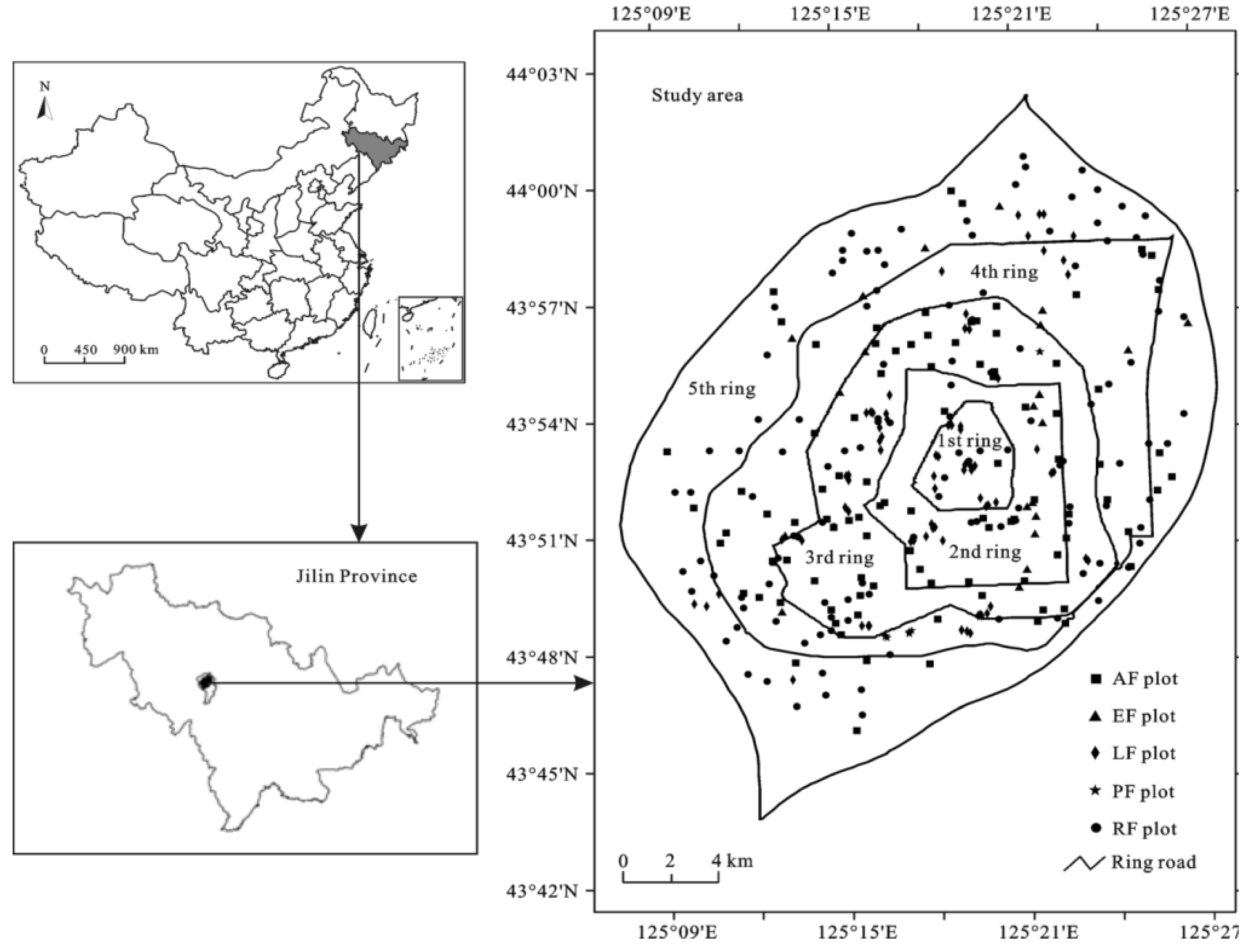
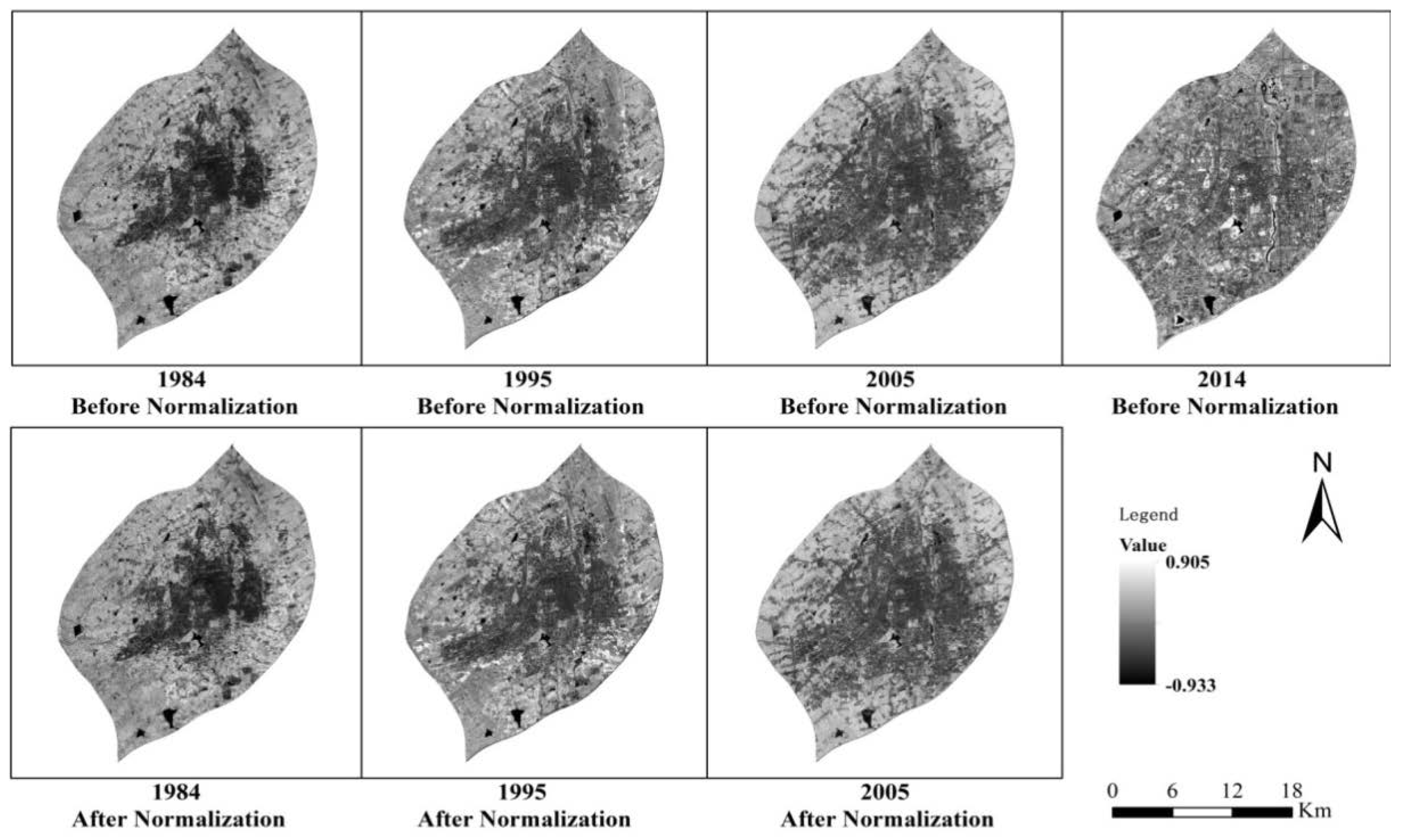
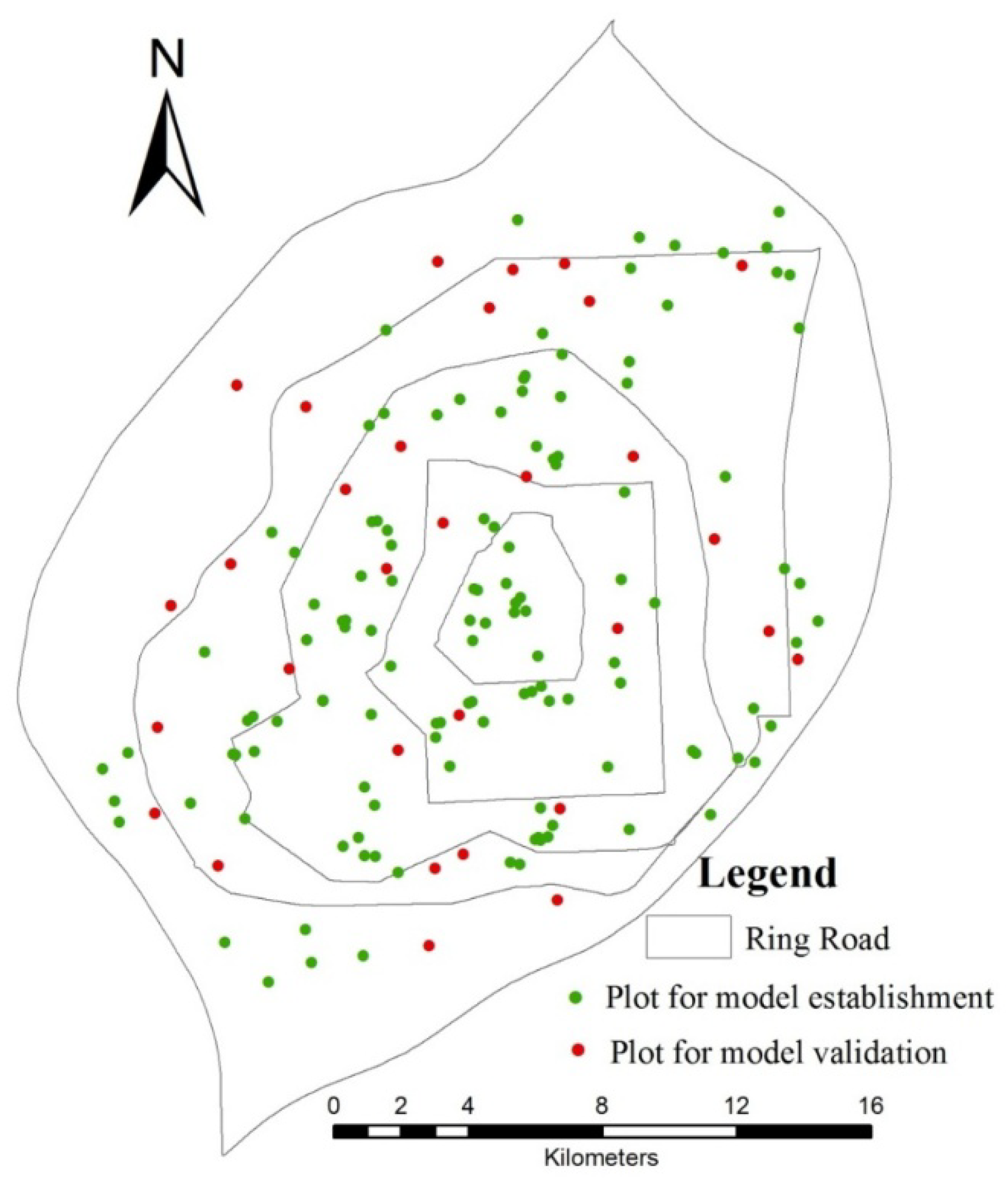
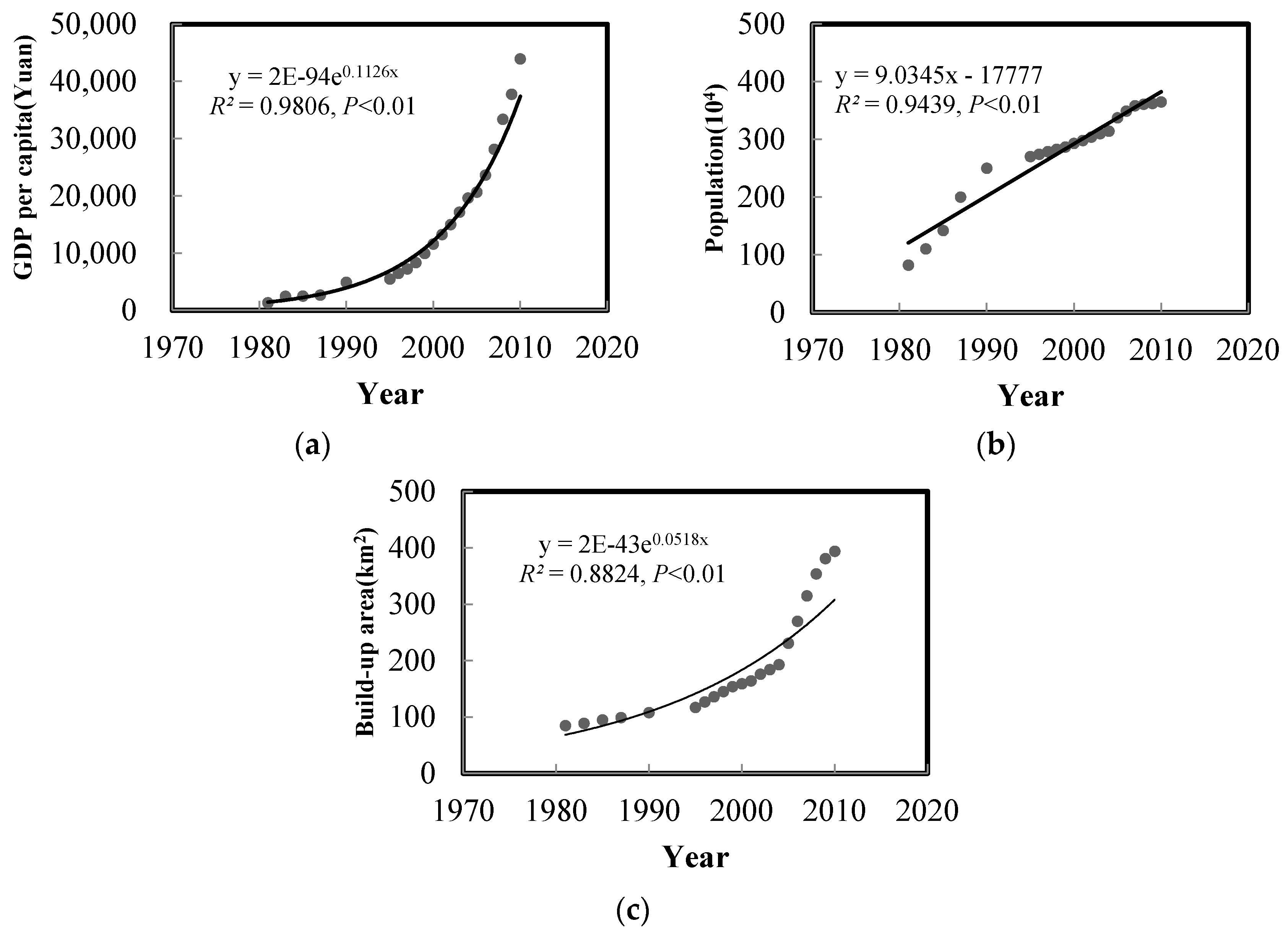
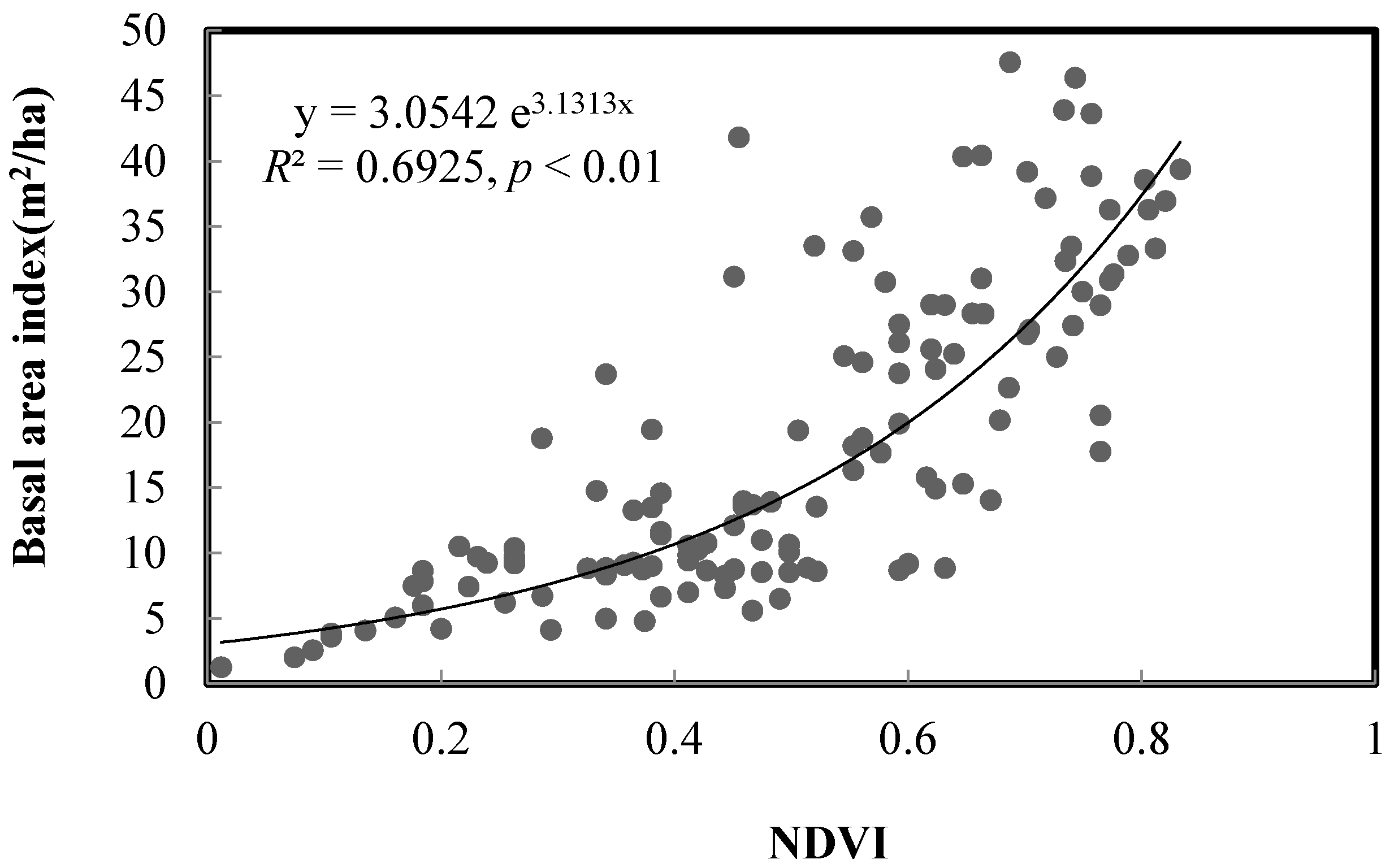
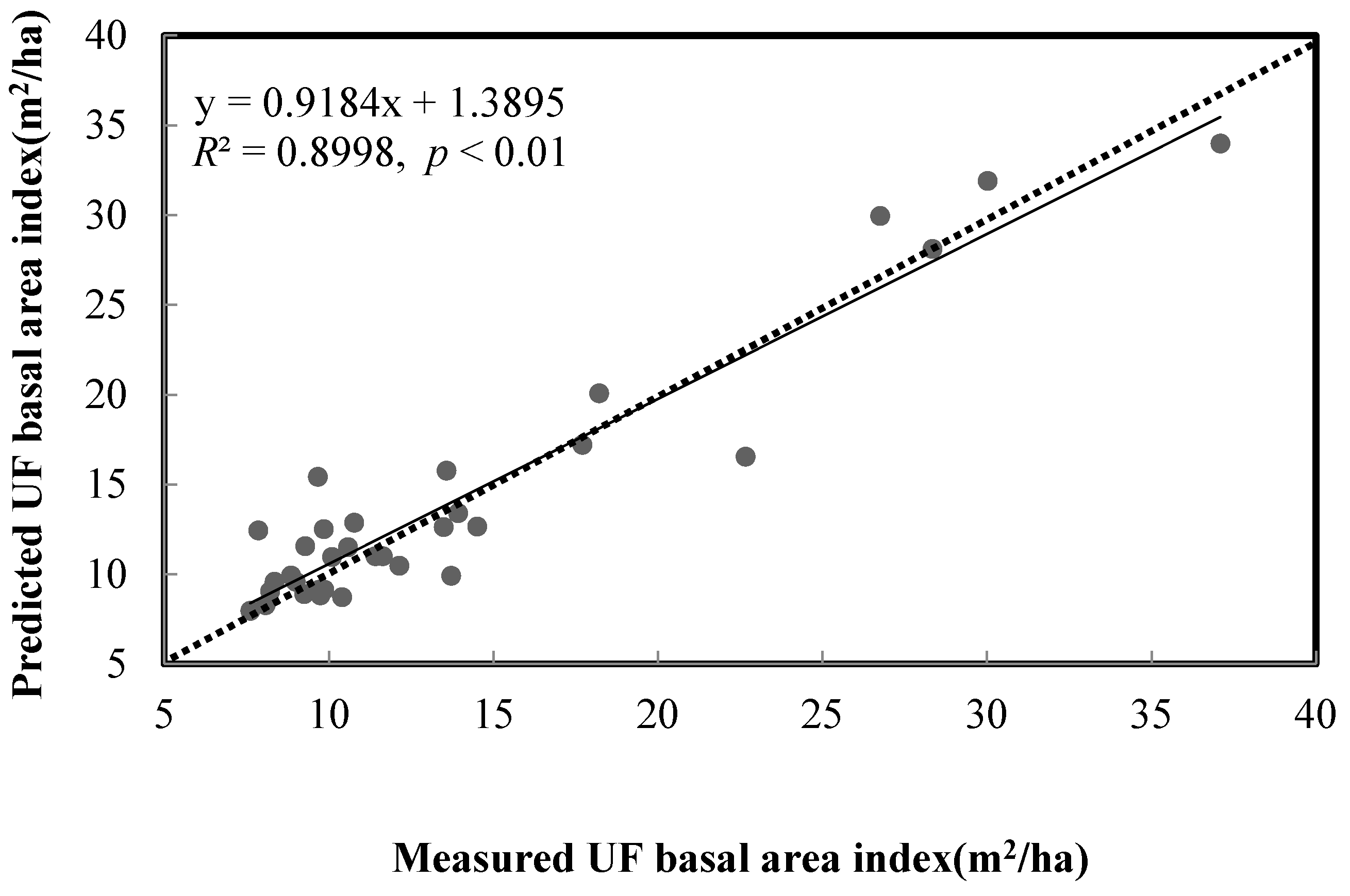
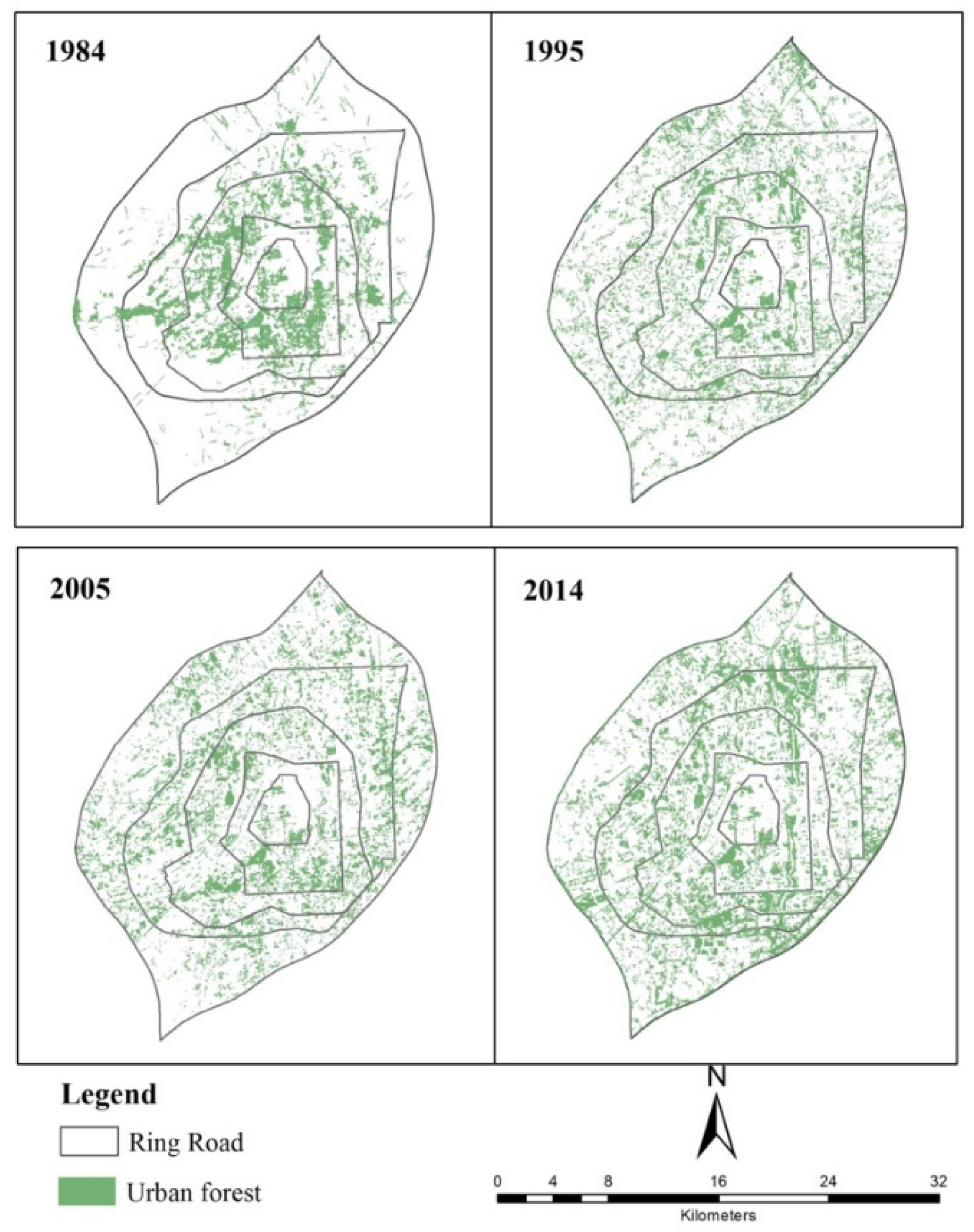
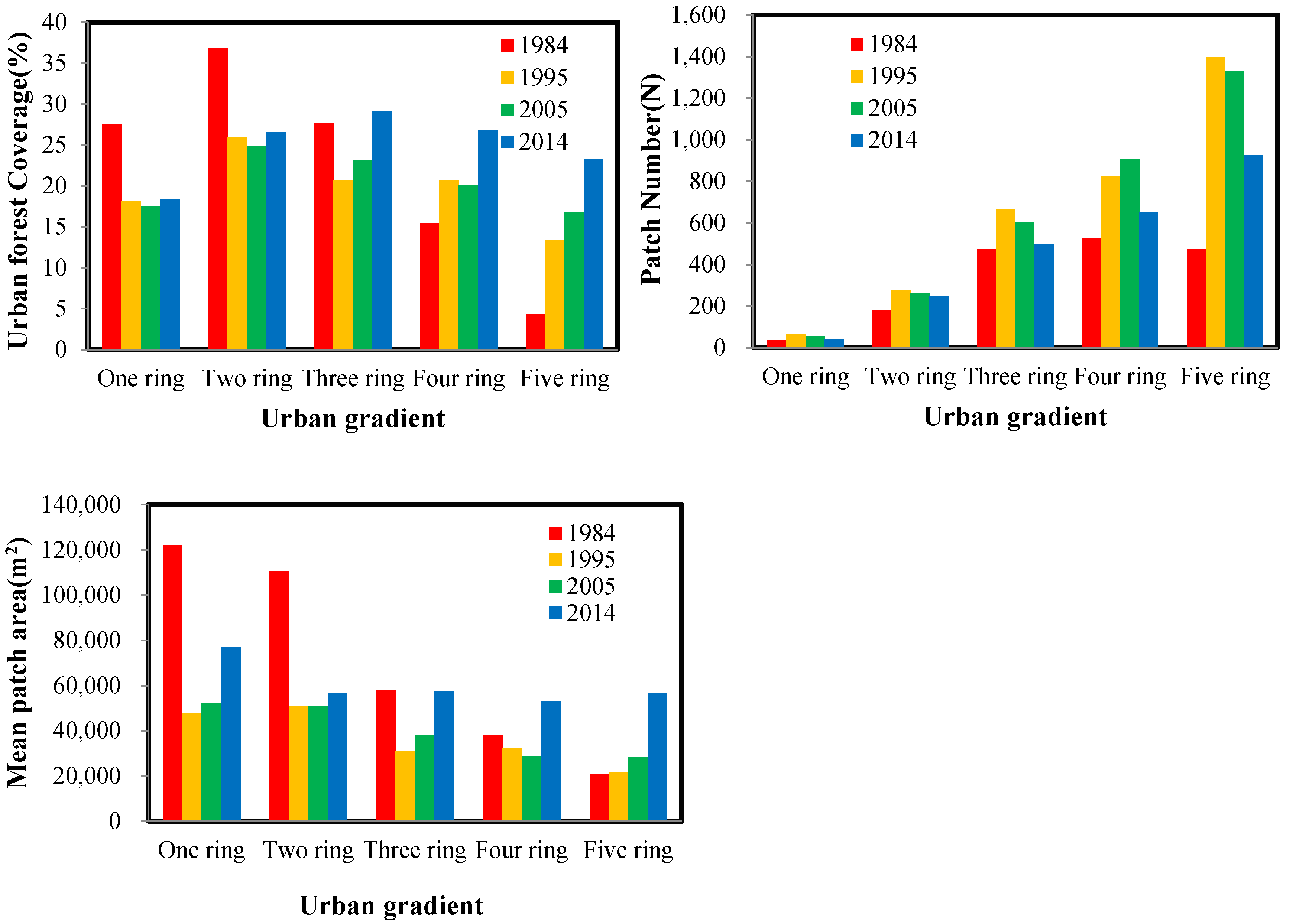
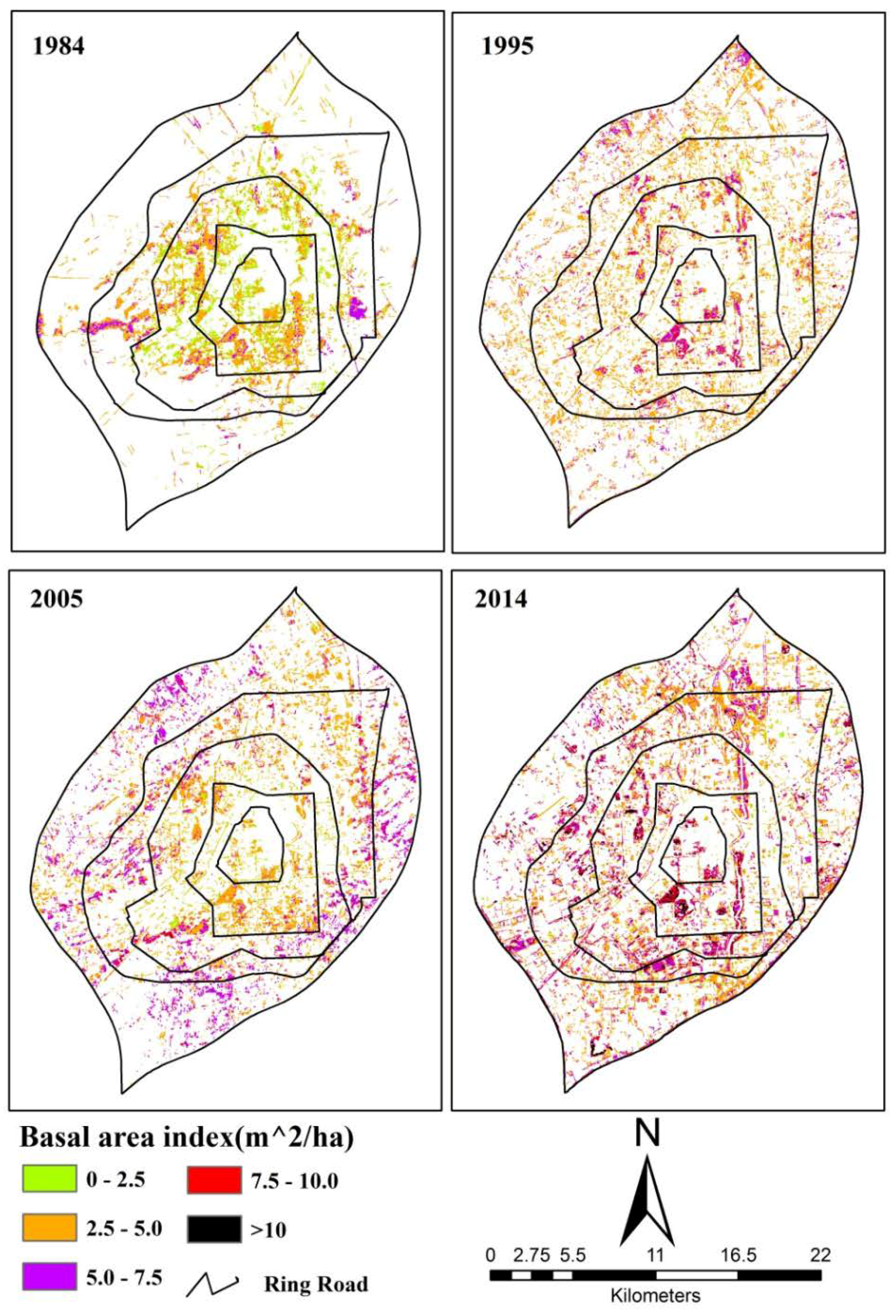

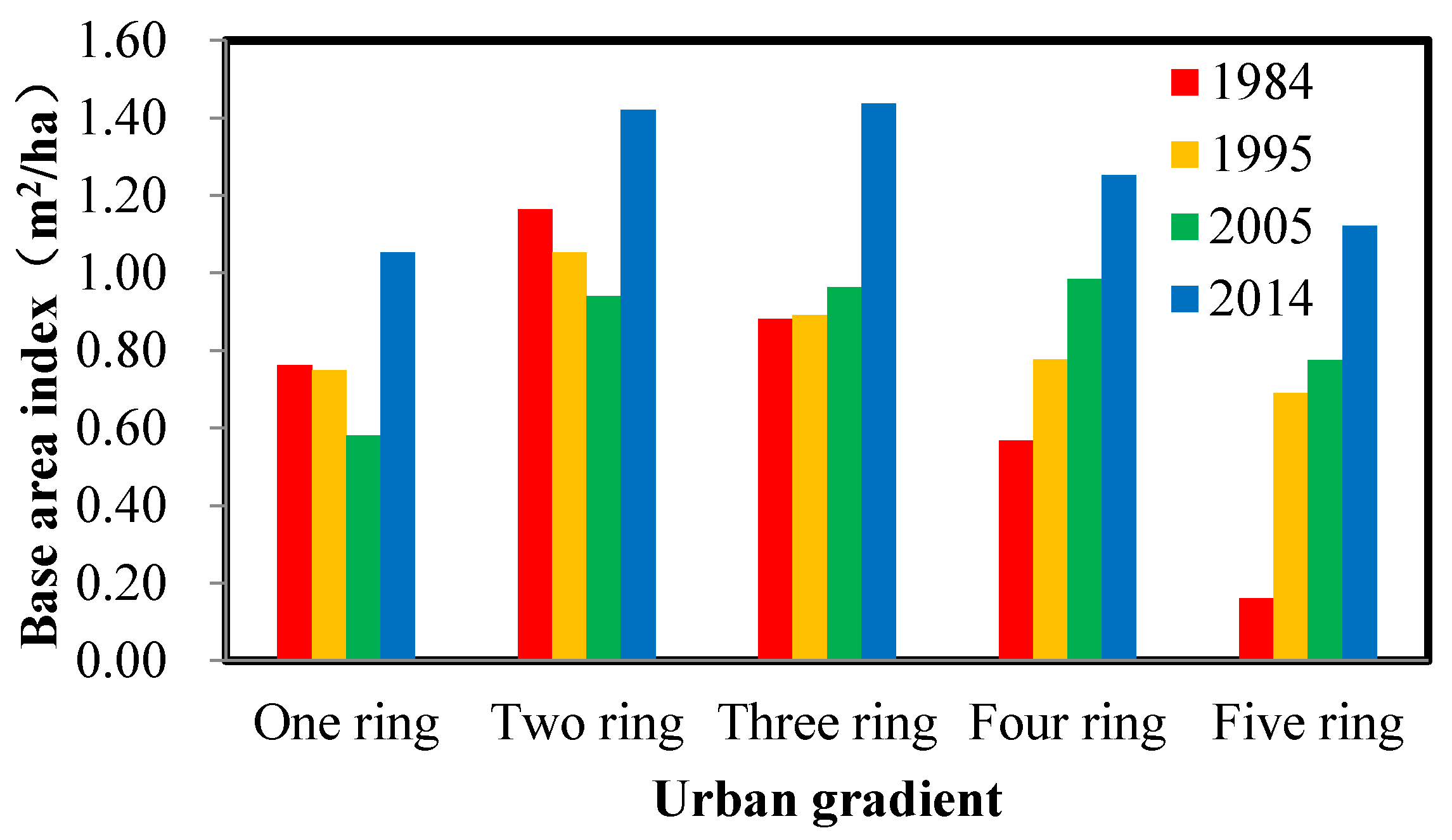
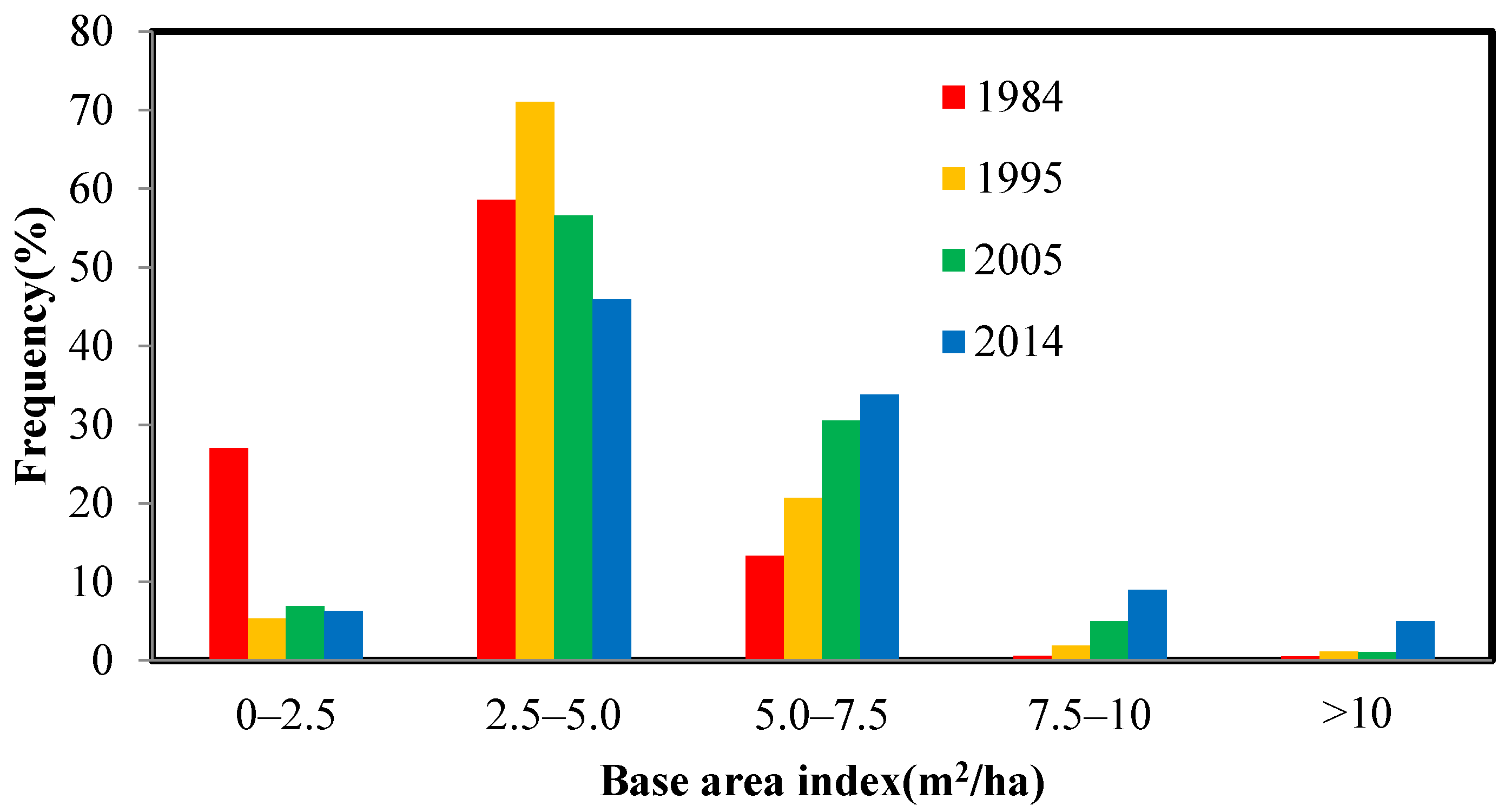
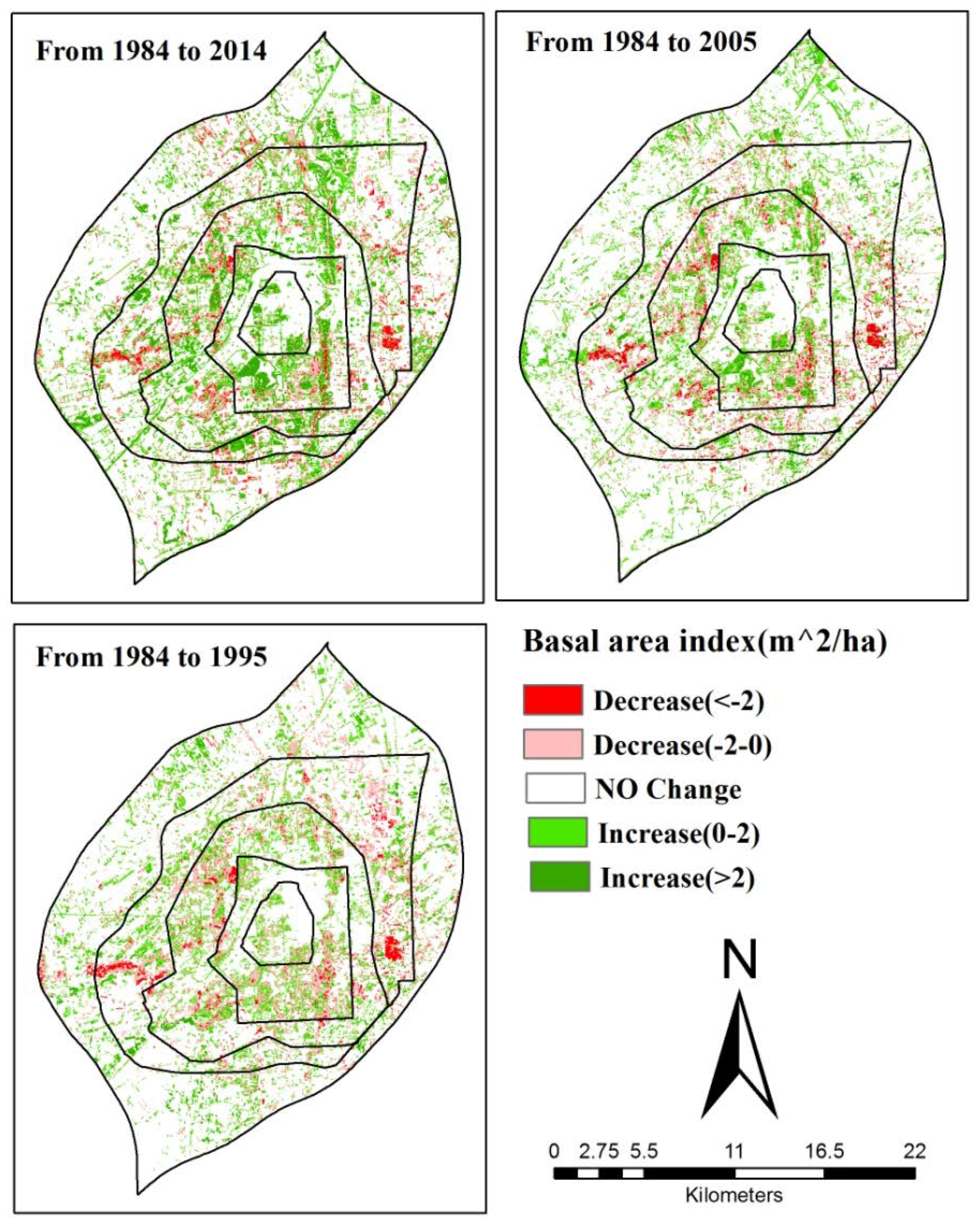
| 1984 | 1995 | 2005 | |
|---|---|---|---|
| a | 0.712 ** | 0.745 ** | 0.876 ** |
| b | −0.154 ** | −0.103 ** | −0.095 ** |
| R2 | 0.725 | 0.712 | 0.842 |
| p-value | 0.00 | 0.00 | 0.00 |
| Year | Total UF Area (103 m2) | Coverage (%) | Patch Number (n) | Mean Patch Area (103 m2) | Patch Density (n/km2) | Basal Area (m2) | BA Index (m2/ha) |
|---|---|---|---|---|---|---|---|
| 1984 | 78,585.612 | 0.152 | 1014 | 77.501 | 12.912 | 27,294.725 | 0.521 |
| 1995 | 89,084.842 | 0.174 | 3013 | 29.621 | 33.842 | 41,338.945 | 0.793 |
| 2005 | 104,800.523 | 0.242 | 2934 | 35.719 | 27.934 | 45,760.852 | 0.874 |
| 2014 | 133,564.224 | 0.251 | 2174 | 61.337 | 16.325 | 65,139.626 | 1.245 |
© 2018 by the authors. Licensee MDPI, Basel, Switzerland. This article is an open access article distributed under the terms and conditions of the Creative Commons Attribution (CC BY) license (http://creativecommons.org/licenses/by/4.0/).
Share and Cite
Ren, Z.; He, X.; Zheng, H.; Wei, H. RETRACTED: Spatio-Temporal Patterns of Urban Forest Basal Area under China’s Rapid Urban Expansion and Greening: Implications for Urban Green Infrastructure Management. Forests 2018, 9, 272. https://doi.org/10.3390/f9050272
Ren Z, He X, Zheng H, Wei H. RETRACTED: Spatio-Temporal Patterns of Urban Forest Basal Area under China’s Rapid Urban Expansion and Greening: Implications for Urban Green Infrastructure Management. Forests. 2018; 9(5):272. https://doi.org/10.3390/f9050272
Chicago/Turabian StyleRen, Zhibin, Xingyuan He, Haifeng Zheng, and Hongxu Wei. 2018. "RETRACTED: Spatio-Temporal Patterns of Urban Forest Basal Area under China’s Rapid Urban Expansion and Greening: Implications for Urban Green Infrastructure Management" Forests 9, no. 5: 272. https://doi.org/10.3390/f9050272
APA StyleRen, Z., He, X., Zheng, H., & Wei, H. (2018). RETRACTED: Spatio-Temporal Patterns of Urban Forest Basal Area under China’s Rapid Urban Expansion and Greening: Implications for Urban Green Infrastructure Management. Forests, 9(5), 272. https://doi.org/10.3390/f9050272







